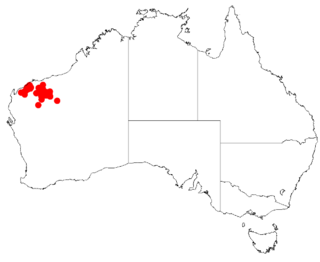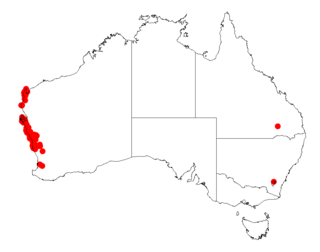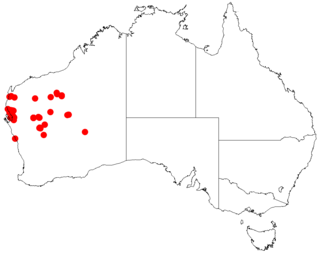
Acacia atkinsiana, commonly known as Atkin's wattle, is a shrub belonging to the genus Acacia and the subgenus Juliflorae endemic to Australia. The indigenous peoples of the area where the shrub is found, the Kurrama peoples, know the shrub as Bilari or Pilarri.

Acacia bromilowiana, commonly known as Bromilow's wattle, is a tree belonging to the genus Acacia and the subgenus Juliflorae that is endemic to a small part of north western Australia.

Acacia effusa is a shrub belonging to the genus Acacia and the subgenus Juliflorae that is endemic to north western Australia.

Acacia hamersleyensis, also known as Karijini wattle or Hamersley Range wattle, is a tree or shrub belonging to the genus Acacia and the subgenus Juliflorae. It is endemic to a small area in central Western Australia.

Acacia macraneura, commonly known as big mac wattle, is a shrub belonging to the genus Acacia and the subgenus Juliflorae that is native to arid parts of western Australia.

Acacia rhodophloia, commonly known as minni ritchi or western red mulga, is a tree or shrub belonging to the genus Acacia and the subgenus Juliflorae that is endemic to a large area of arid central western Australia. The Indigenous group the Kurrama peoples know the plant as mantaru.

Acacia thoma is a shrub belonging to the genus Acacia and the subgenus Juliflorae that is endemic to arid areas of western Australia.
Acacia minutissima is a shrub belonging to the genus Acacia and the subgenus Phyllodineae that is endemic to parts of western Australia.

Acacia robeorum, commonly known as Robe's wattle, is a shrub of the genus Acacia and the subgenus Phyllodineae that is endemic to north western Australia.

Acacia ryaniana is a shrub of the genus Acacia and the subgenus Phyllodineae that is endemic to an area along the west coast of Australia.

Acacia scalena is a shrub of the genus Acacia and the subgenus Phyllodineae that is endemic to a small area in western Australia.

Acacia spathulifolia commonly known as Gold carpet or the Gold carpet wattle is a shrub of the genus Acacia and the subgenus Phyllodineae that is endemic to coastal parts of western Australia.

Acacia anaticeps, also known as duck-headed wattle, is a shrub or tree of the genus Acacia and the subgenus Plurinerves. It is native to arid areas of north western Australia.
Acacia anserina, also known as hairy sandstone wattle, is a shrub of the genus Acacia and the subgenus Plurinerves. It is native to a small area in the Kimberley region of Western Australia.

Acacia arrecta, commonly known as Yarnda Nyirra wattle or Fortescue wattle, is a shrub of the genus Acacia and the subgenus Plurinerves that is endemic to arid areas in north western Australia.

Acacia galeata is a shrub or tree of the genus Acacia and the subgenus Plurinerves that is endemic to an area of western Australia.

Acacia roycei is a shrub or tree of the genus Acacia and the subgenus Plurinerves endemic to an area of western Australia.

Acacia sibilans, commonly known as the whispering myall, is a shrub or tree of the genus Acacia and the subgenus Plurinerves thar is endemic to an arid areas of central western Australia.

Acacia speckii is a shrub or tree of the genus Acacia and the subgenus Plurinerves that is endemic to a small area in central western Australia.
Acacia exilis, commonly known as muntalkura wattle, is a species of wattle belonging to the genus Acacia and the subgenus Juliflorae. The Kurrama peoples know the tree as jonanyong or jananyung. It is native to an area of the Pilbara region of Western Australia.

















